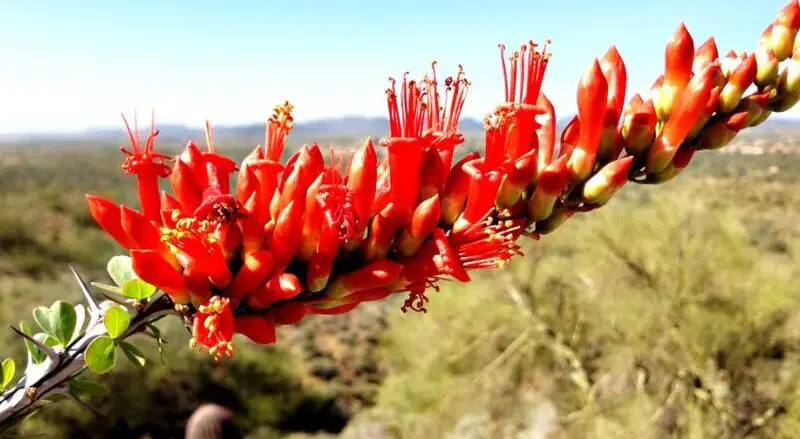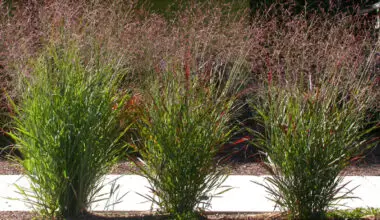The Ocotillo plant ( Fouquieria splendens ) is a desert shrub that produces a show of bright pink flowers on whip-like canes. It is often called ocotillo cactus, but is not really a cactus, although it grows in similar conditions. The plant is native to the Sonoron and Chihuahua deserts.
Canes can grow up to 20 feet long in the wild, but are more likely to get 6 to 10 feet in cultivation. Ocotillo is suitable for xeriscapes, rock gardens and warm climate container gardens.
Contents
Planting Ocotillo
Ocotillo should be planted in a hole twice as wide as the root system, but no deeper. It should go into the soil at the same level it was originally growing. Most ocotillo found in nurseries will be bare root and should be well supported in the soil.
The Ocotillo plant is then irrigated once a week during the summer while established. Water infrequently in the winter and continue to take good care of the ocotillo by thinning it around the roots with stones to keep it from falling over and to conserve moisture.
Ocotillo Care
Pruning and growth of the ocotillo
The plant’s most distinctive feature is its long, upright, pole-like branches.
The plant branches very strongly at the base, but does not show secondary branching – the long, pole-like stems almost always remain unbranched.
The stems are very slender with a maximum of 2 inches in diameter at the base, but can reach up to 33 feet in their natural habitat.
However, in cultivation, they most often reach 6 to 10 feet.
The stems are partly green and covered with blunt spines, which are actually old, hardened leaf stems.
For most of the year, the plant remains leafless, resembling a bunch of large spiny stems.
But, it quickly turns a lush green, filled with small oval leaves, after rain.
The leaves remain on the plant for several weeks, sometimes even months.
When growing an ocotillo plant at home, choose a location where it receives sunlight on its south side because it has evolved to become more resistant to sunlight and heat.
Watering and feeding ocotillo
Newly transplanted plants should be watered moderately until they are established.
The watering requirements of the established thin wood plant are very low.
They can even survive without water if they receive an average of 8 inches of rain per year.
Just make sure they are planted in an unrestricted area; where surface water does not pool or remain.
Although this species of Fouquieria is fairly drought tolerant, extreme drought can cause the plant to lose its leaves.
The loss of leaves is temporary, however, and they grow back after spring or summer rains.
Soil and transplanting
Desert coral grows best in well-drained, gravelly or sandy loam soil mixed with a small to moderate amount of organic matter.
The plant transplants at any time of the year.
But, you must be careful when planting ocotillos as transplanting large bare root plants is rarely successful.
Ideally, ocotillos should be planted in their original location from the beginning, just like cacti.
Maintenance of the ocotillo
As long as the Fouquieria plant receives plenty of sun and warmth, it continues to grow without any problems and does not even require any grooming or maintenance.
However, prune dead and broken stems to improve its appearance.
Multiplying and propagating Ocotillo
When to propagate Ocotillo
When it comes to propagating, ocotillo plants tend to be somewhat unpredictable and success tends to be hazardous. You can try to start a new plant at any time of the year, but in the desert climate, the best time is during the winter rainy season when the extra moisture and cooler temperatures provide better rooting conditions.
How to propagate Ocotillo by cuttings
There are two ways to propagate ocotillo plants with cuttings – either in the ground or using containers. Let’s start with the simpler method first.
In the ground: Traditionally, propagating ocotillo simply involved sticking rods into the ground. This technique usually has a pretty good success rate. If you want to try, simply cut several sticks when they are flexible and not stiff or hard. Gather them into a bundle and wrap the bundle with string or yarn to make it easier to handle.
Dig a hole at least 4 to 6 inches deep (10-15 cm.), then plant the bundle in the hole. Wrap the soil tightly around the sticks and lay it down to help it stand up. Water well, but do not change the soil even if it is poor and do not add fertilizer. Sit and wait, as rooting can take months.
Using a container: You can also plant ocotillo sticks in a heavy pot filled with a sand mixture. Make sure the pot has at least one drainage hole. Strip the leaves from the bottom section that will be in the soil to prevent rotting, and remove a few inches from the top if the chopsticks are too tall to stand.
Put the pot in a sunny spot and keep the soil slightly moist until new growth appears, indicating that the cuttings have taken root. Thereafter, water every two weeks during the first spring and summer, then reduce to monthly irrigation in fall and winter. After the first year, ocotillo rarely needs water, although an occasional drink is beneficial during the hottest part of the year.
Diseases and pests of ocotillo
The plant has no known disease problems.
While pest infestations are also not common in cockroach plants, it is recommended to watch out for sucking and scaling insects, which can use the plant as a food source.
In case they attack your ocotillo plant, treat with an insecticidal soap.
Native carpenter bees and hummingbirds act as pollinators for this plant native to the United States and Mexico.









